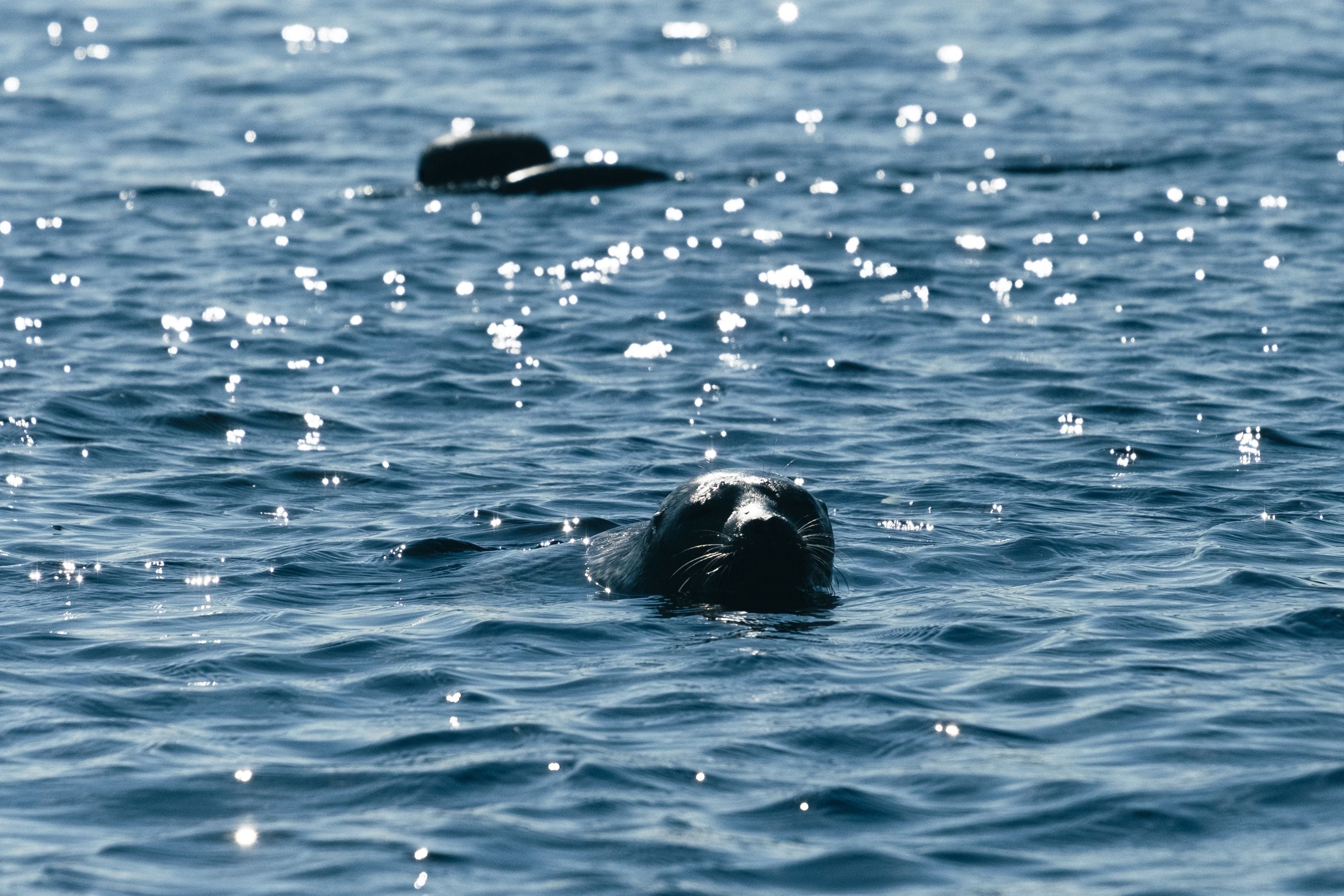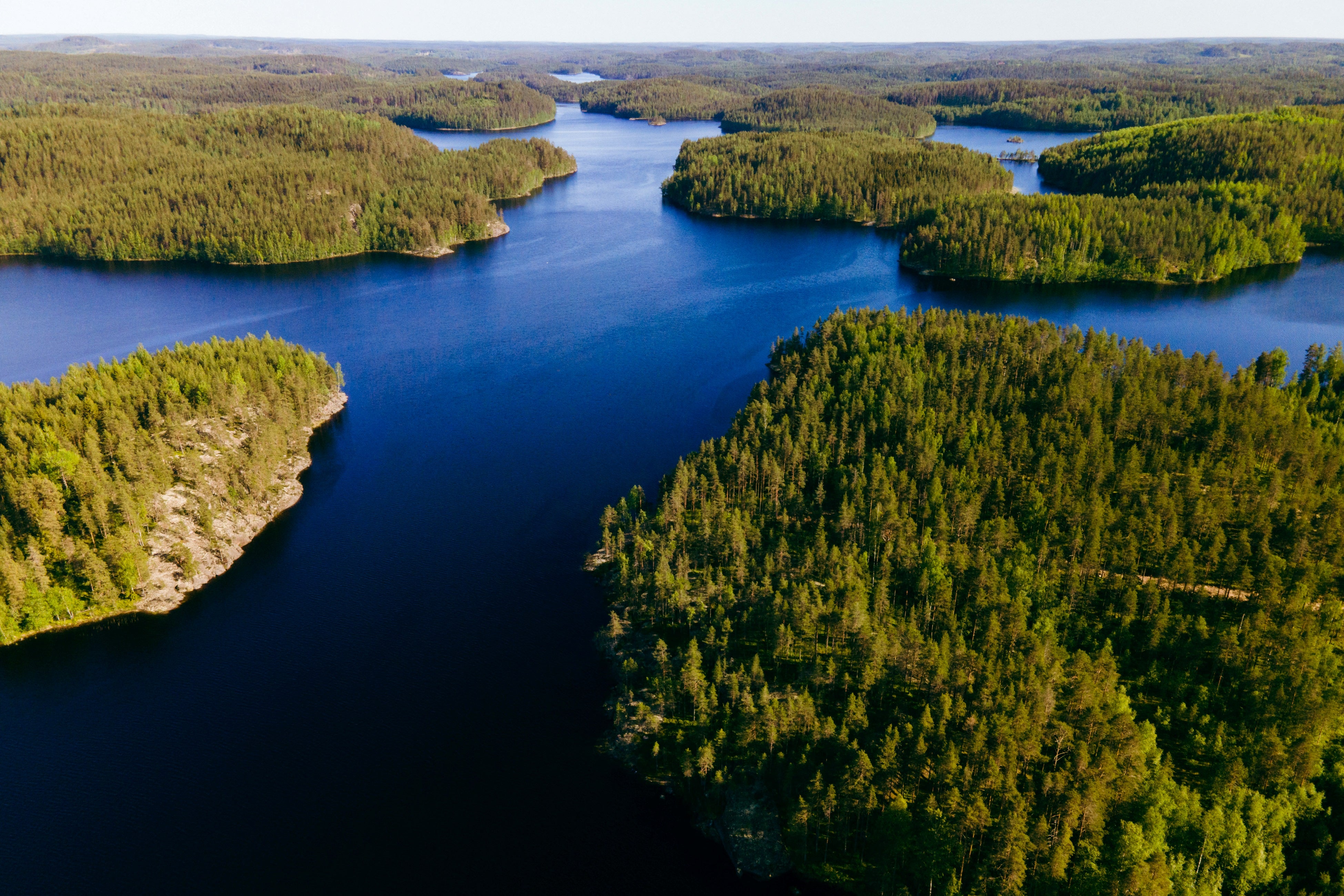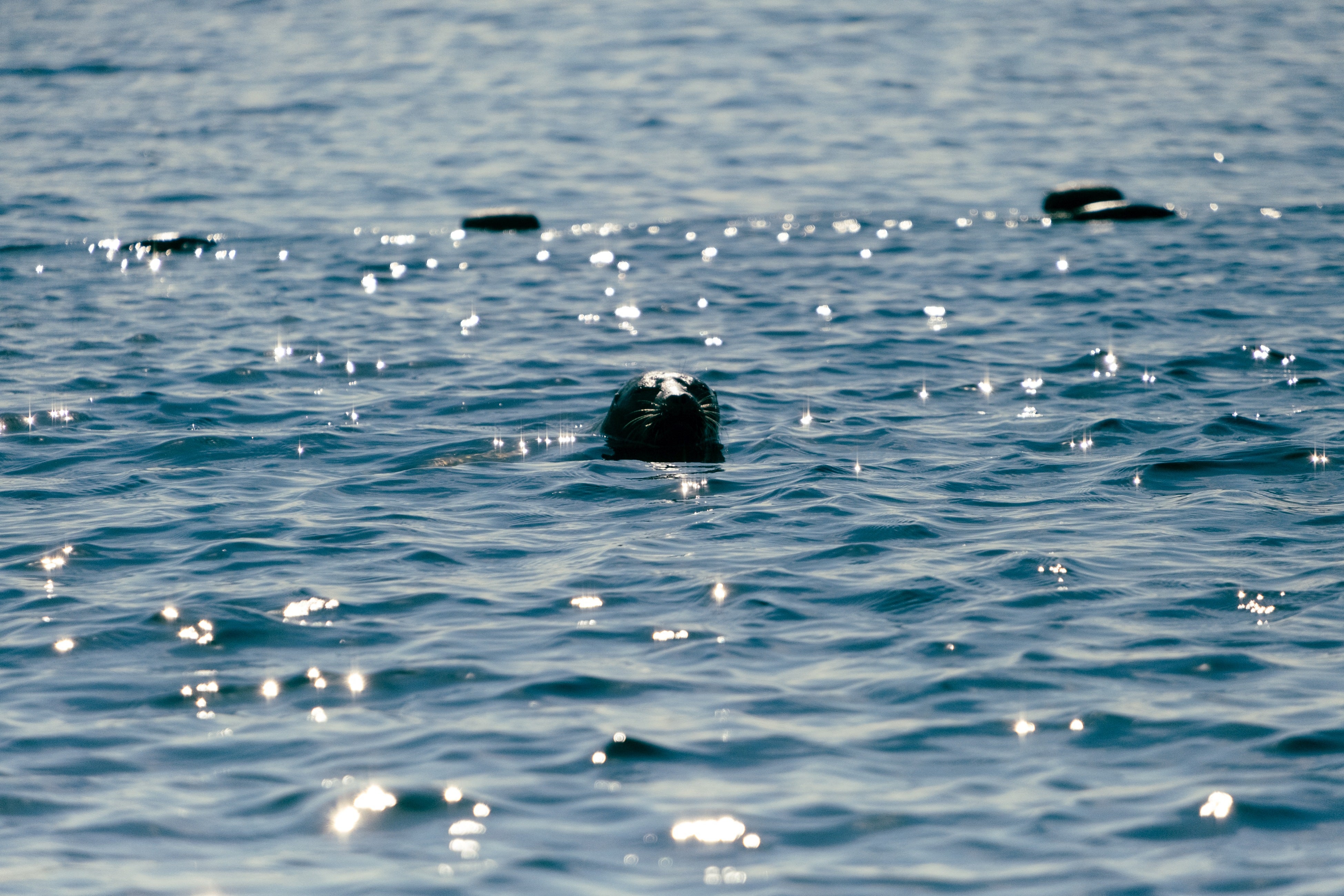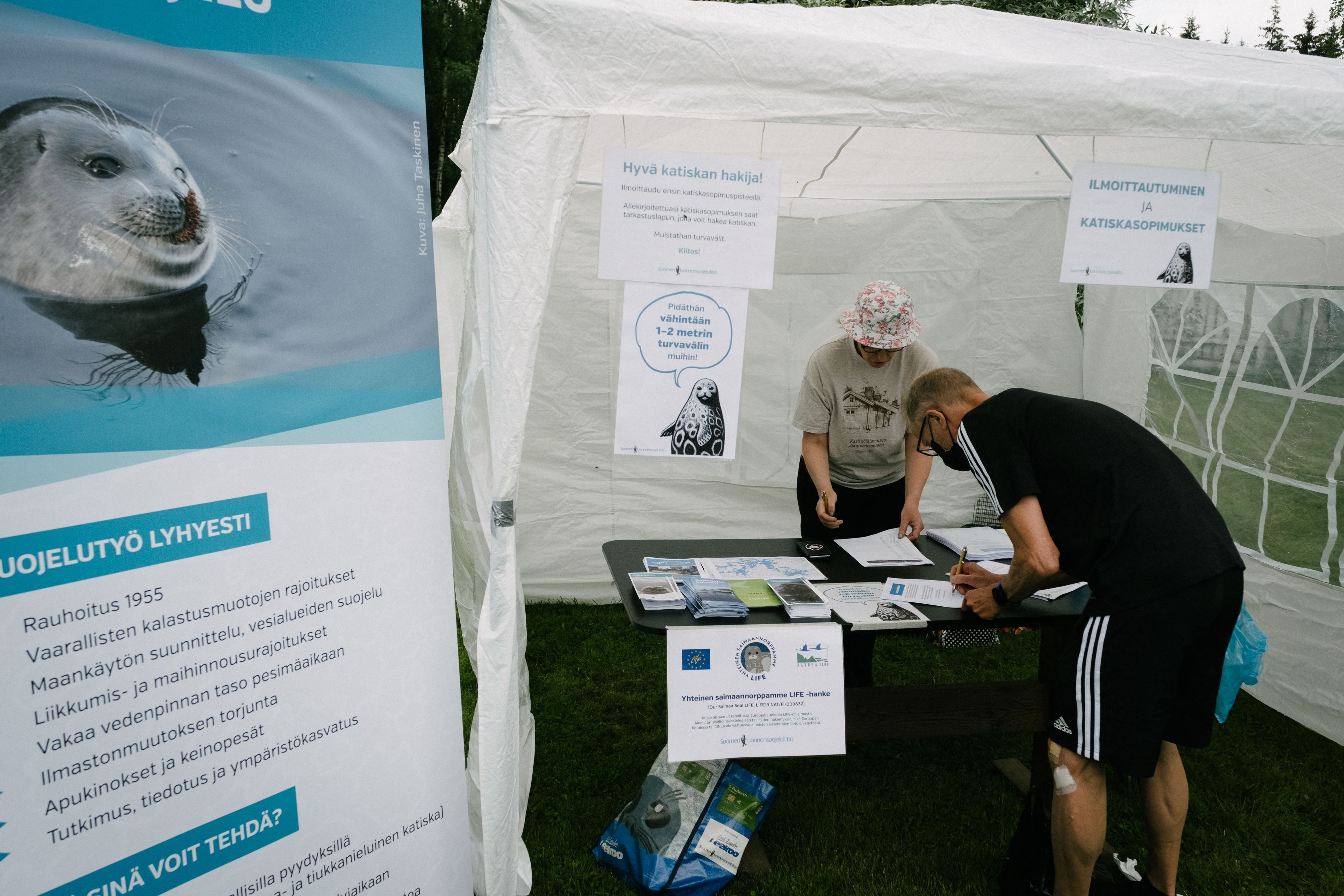Inside the fight to bring the Saimaa ringed seal back from the brink of extinction
Efforts including human-made snowdrifts, genetic transfer and floating homes have brought seal numbers from 150 to more than 400, writes WS Roberts

Saimaa ringed seal mothers and their newborns have huddled in pupping lairs along the shores of this inland archipelago in southeastern Finland since time immemorial. Expectant females shape their lairs by putting a hole through the ice under a snowdrift, then burrow a chamber where they give birth and raise their young, well-protected from predators during the frigid winter months.
But now a new model is in service.
“We can get some individuals in artificial nests, and they learn to use those, and then the pups learn,” says Miina Auttila, a conservation specialist helping to drive efforts to protect the endangered seal. She is projecting an image of a fabricated lair onto a screen at the local office of Metsähallitus, Finland’s state-run land and waters department, here in the shoreline town of Savonlinna. The human-made lair looks like an igloo with skates, but it may be the seal’s best chance for survival because the snow the seal relies on for its lifecycle is in increasingly short supply due to climate change.
Since 2006, there have been years when the pups are born with no snow on the ice, explains Auttila. The lack of cover exposes them to predation, particularly by the red fox, as well as human-caused disturbances. Because the animals are as intelligent as canines and can live up to 30 years, Auttila says she is hopeful the ploy will work over time. “That’s why we are also building and developing those artificial nests.”
The prototyping of birth lairs is the latest innovation by Finnish conservationists in their decades-long fight to protect the Saimaa ringed seal, one of the rarest pinnipeds in the world. At about 5ft in length and weighing up to 200ibs, Pusa hispida saimensis is one of five ringed seal subspecies. Its ancestor is believed to have been common across the waterways over much of Finland at the end of the last ice age when melting glaciers filled the scoured-out basins they left behind over much of Scandinavia.
Eventually splitting from its saltwater parent population, the seal settled into what would become Lake Saimaa – a sprawling, 1,700sq mi freshwater complex of peninsulas, straits, and 14,000 islands – from which it derives the first part of its common name. The second part is from the ornate white rings dappling the seal’s dark coat.
While the Saimaa ringed seal’s population is thought to have once reached as high as several thousand, its numbers began a precipitous decline over a century ago when bounties were placed on its head.

Many people in the surrounding communities at that time still lived off the land and depended on fishing as a supplemental food source, explains Arto Keinänen, a tour and fishing guide on Lake Saimaa for over 10 years. The seal was seen as a competitor that tore apart handwoven gillnets and threatened livelihoods. “For this reason,” says Keinänen, “people hated the seal.”
A ban on hunting the seal was instituted in 1955, though its population continued to decline, dropping to less than 150 by the early 1980s. The principal culprit was, as it is today, bycatch from gillnetting. The rising environmental awareness of that era caught the seal just in time.
“People were aware that the population was declining,” says Jari Luukkonen, conservation director for the World Wide Fund for Nature-Finland. So, in 1979, WWF formed the Saimaa seal working group, uniting concerned parties to better understand the plight of the seal. “The main issue was net fishing … plenty of these young pups drowned in the nets during their first months,” explains Luukkonen. Within a few years, WWF began brokering protection agreements with fishing collectives to stop using gillnets – which had modernised to nylon mesh the seal could not readily bite through – during spring after ice melt.
But after so much progress, the seal is still vulnerable to random, singular events that could force it into extinction. And there are winters now when there isn’t even enough snow for volunteers to scrape into snowbanks
Governmental organisations from the municipal to national level soon followed suit with their own legislative manoeuvers. And in the ensuing decades, fishing regulations steadily limited hazardous gear, while enlarging restricted areas the Saimaa ringed seal was known to frequent. A moratorium on gillnetting in designated seal sanctuaries from mid-April to the end of June – when pups wean from their mother and which research showed 75 per cent of bycatch occurred – was also enacted.
With a surrounding human population of 286,000, fishing is a common pastime on Lake Saimaa, as it is in much of Finland. Of the 80,000 households that enjoy recreational fishing on the lake, it is estimated that 30,000 use gillnets.
The seal, however, is no longer so reviled. Keinänen credits governmental authorities and organisations like WWF for educating and changing attitudes. “The heart of people is now positive and for the protection of the seal,” he says.
Petteri Tolvanen, head of WWF’s Finnish biodiversity programme, who works with other stakeholders to renew fishing regulations on the lake, says these are “clearly the main reason why the [seal] population is now increasing.” And although not all are in favour of the restrictions, regulation committees understand that the restriction areas must expand “according to the breeding area of the seal … and it is accepted very well.”
Still, the Saimaa ringed seal population has not recovered as quickly as expected. Further research has been needed to discover why, along with new solutions to protect the animal. And since Finland is part of the EU, the species – designated as endangered by the International Union for Conservation of Nature – falls under the EU’s strict Habitats Directive requiring member states to protect threatened flora and fauna, such measures are mandatory.

So, two efforts – the LIFE Saimaa Seal Project followed by the Our Saimaa Seal LIFE Project – have pursued the seal’s rescue with renewed vigour. Mostly funded by the EU and coordinated by Metsähallitus, the 10-year, €12m programme ending in 2025 was vital to shaping the spring moratorium on gillnetting and the expansion of protected areas – and has also introduced a vigorous public relations campaign, seal-safe fish traps, and a photo ID study.
It is perhaps the piling of snowdrifts, however, that is the programme’s most unexpected breakthrough: when winter weather fails to deliver enough of the wet stuff for mother seals to burrow birth lairs, project members and enlisted volunteers are mustered to designated locations where they take to the ice with snow shovels in hand.
Scooping what snow there is into 12m long, 5m wide and 1m high mounds along the shoreline, the piles emulate the accumulation expectant seals look for when searching to excavate a lair, and hold together long enough for the pups to finish up to 12 weeks of nursing. The scheme has proven a resounding success: over a recent five-year period, some 300 volunteers shovelled over 1,000 snowdrifts; more than 70 per cent of recorded pups were born in these human-made mounds. A lot depends on the size of the team, says Tolvanen, but “in the worst case, when there is practically no snow and ice and you have to try collect some snow from the small islets, [building a snowdrift] can take two hours or more.”
Such inspired measures helped lift the Saimaa ringed seal population to more than 400. But after so much progress, the seal is still vulnerable to random, singular events that could force it into extinction. And there are winters now when there isn’t even enough snow for volunteers to scrape into snowbanks; like the 2019-2020 season when, for the first time in “conservation history,” the southern extent of Lake Saimaa did not ice over. A recent study estimates that thermal winter in northern Europe will contract by 30-60 days over the next few decades.

“It takes a little out of the box thinking to get the seal in the box,” says Mervi Kunnasranta, who has studied the Saimaa ringed seal for over 30 years, and now leads the Saimaa ringed seal research group at the University of Eastern Finland, a partner of the LIFE projects. Kunnasranta works closely with Auttila, the Metsähallitus conservation specialist, and is advising engineers on the construction of artificial lairs, another novel conservation tactic.
Building artificial lairs to the seal’s liking required relentless innovation: the box must be rugged on the outside to endure the elements, and supple but strong enough on the inside to both allow and contain burrowing. Acoustics are also important.
“If you go inside the metal box, it is noisy,” says Kunnasranta, stressing the need to negate disturbances that can upset seals. To entice the animal, she says, the box must also feel like a seal’s lair, “so maybe they think that [another seal] has made them.”
Auvinen is quick to emphasise that the seal’s constricted genome does not necessarily impact the seal’s fitness, but the lack of variation may fail to shield the seal from threats yet to emerge from a changing environment
Ten versions or so later – some had too many parts to be viable, another type broke apart from a feisty pup’s constant thrashing – the team has nearly settled on an aluminium-covered construct with plastic pontoons to keep it afloat. Lamb’s wool has seemed to have met the interior’s pliancy and noise suppression requirements. Throughout the prototyping process, half of the 34 boxes were visited by seals, with two successful births.
Kunnasranta believes the success of the synthetic lairs – like the shovelling of snowdrifts – will rely on volunteers. She envisions a total of one hundred boxes that are maintained by local residents as warmer winters bear down on Lake Saimaa, with the goal of supporting about 90 births annually. “I’m quite certain that people are excited to do it,” she says.
The 1980s population bottleneck also pinched the seal’s genome, raising the threat of genetic drift. “Things … are very bad, but they could be worse,” says Petri Auvinen who, as research director at the University of Helsinki’s Institute of Biotechnology, sequenced the genomes of 105 deceased Saimaa ringed seals in a bid to identify the species’ genetic variability. The work discovered that the seal’s genome is “highly homozygous which, as a consequence, means there is less variance there and the genome has less potential for adaptation.”
Auvinen is quick to emphasize that the seal’s constricted genome does not necessarily impact the seal’s fitness, but the lack of variation may fail to shield the seal from threats yet to emerge from a changing environment. He draws parallels to the harbour seal that suffered die-offs in the tens of thousands when infected with the canine distemper virus.

Still, and because the Saimaa ringed seal’s population is divided into several non-overlapping subpopulations – each isolated into their own parts of the lake – the research suggests there remains some genetic variation between these areas that otherwise might not have been preserved if it weren’t for the lake’s far-flung, labyrinthine geography. This offers the programme team an opportunity to rescue genotypes.
“We cannot increase the [seal’s] genetic diversity because we are doing everything within the lake, but we can maintain the current diversity and that’s the goal,” says Kunnasranta, who is planning to use Auvinen’s research to help identify a small number of seals to capture and move into other subpopulations to mix genes, beginning in 2023.
The team may also consider transplanting seals from congested areas to more protected waters; though the Saimaa ringed seal remains a cause célèbre among visitors who now board seal-watching tours, hoping to catch the chubby pinniped on the rocks, basking in the sun.
Raisa Tiilikainen, who manages the Saimaa ringed seal Life programme for Metsahallitus, says the seal is also curious about people, and that at times “it makes you wonder who is watching who”. But you won’t see the seal when it starts to pour down, she laughs. “The seal doesn’t like rain … When it rains, they are just in the water.”




Join our commenting forum
Join thought-provoking conversations, follow other Independent readers and see their replies
Comments